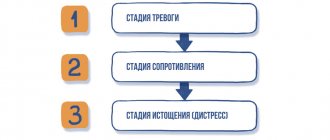O.I. Sukhoveeva
teacher at the Volga Institute
advanced training of the Federal Tax Service of Russia,
Candidate of Psychological Sciences
Today, professional stress is a very serious social phenomenon that is progressing at a tremendous pace. A person’s reaction to a stressful situation is manifested not only in psychological and emotional stress, health and performance suffer, and the quality of life in general changes. The employee is in a state of constant fatigue and loss of energy, and health problems appear. “I don’t have a job, but a lot of stress”, “I’m under constant stress”, “Such nervous stress is simply unbearable” - we can often hear such phrases from the lips of a working person. Indeed, the modern professional environment includes quite a lot of stress factors, the so-called stressors.
Stress is defined as a state of increased tension that occurs in response to a variety of extreme environmental influences.
Professional stress is considered as a tense state of an employee that arises when exposed to emotionally negative and extreme factors associated with the professional activity performed.
You need to understand very clearly that stress is not always bad: it can be beneficial for a person, a stimulator of his activity, and harmful, reducing a person’s resources and activity. According to G. Selye’s definition, such stress is called distress.
Occupational stress most often refers specifically to distress. If an employer is interested in creating safe conditions, high labor productivity, and motivating employees to achieve success in their work activities, then they cannot ignore the topic of preventing occupational stress. Work is truly one of the biggest sources of stress these days.
Psychologists say that the degree of professional stress is evidenced by a special phenomenon called “professional burnout.” The work of most people is rarely calm, measured and devoid of worries and worries. The ability of a specialist to maintain a high level of performance under conditions of psychological stress is a decisive factor for success.
When creating conditions for achieving optimal productivity and activity in professional activities, it is necessary to use systematic and comprehensive knowledge of various areas in science. One of the most important and necessary studies for both managers and ordinary employees of scientific fields is the psychology of work.
Labor psychology studies the patterns of labor activity, development and formation of a person in the process and as a result of work. One of the tasks of occupational psychology is to provide conditions for safe and effective work and to ensure the performance of employees.
In order to cope with stress, you need to understand its nature very well.
N.V. Samukina identifies the main types of professional stress (distress):
Information stress is stress associated with a high degree of decision-making responsibility in conditions of uncertainty and lack of necessary information, as well as with frequent and unexpected changes in information parameters
Emotional is stress that arises from real or perceived danger; experiences of humiliation, anger, resentment; contradictions in relationships with colleagues or management
Communication is stress associated with real problems of business communication and manifests itself in increased irritability; inability to defend against communicative aggression; failure to formulate the necessary refusal. The main manifestations of communicative professional stress are most often: irritability in business communication, the habit of communicating in a raised voice; dissatisfaction with one's job, communicative aggression: the desire to humiliate or suppress an opponent in competition, verbal aggression; open challenge to conflict, pickiness, hints, refusal to help, lies, pettiness, threats; spontaneous outbursts of rage; directed at another (blaming another) or at oneself (self-blaming).
What are the behavioral and emotional consequences of stress?
When you are under psychological pressure, you may experience many different feelings, including anxiety, irritability, loss of control, which will cause you to become withdrawn, indecisive and whiny.
You experience periods of constant worry, racing thoughts. You experience changes in your behavior and find it difficult to concentrate and manage stress. You lose your temper more easily, act irrationally, or become more aggressive. All these feelings lead to changes on the physical level. For example, extreme anxiety, panic attacks, causing attacks of dizziness and rapid heartbeat will make you feel so bad that you begin to seriously worry about the health of your heart and/or blood vessels. And only a doctor will help you recover. But prevention is much more important.
Psychologists most often identify the following factors of professional stress:
- The employee’s working day is associated with high temporary overload, irregular working hours;
- working conditions do not meet safety and physical comfort requirements;
- an employee works in a situation of time shortage, there are many different tasks, but there is not enough time to implement them, one thing overlaps with another, all matters are urgent;
- the employee is forced to make decisions independently.
- the employee is not sufficiently informed about his professional responsibilities and the powers of his colleagues and superiors;
- high responsibility for other people and for material values;
- low degree of influence on decision making in the organization;
- difficult relationships with management, with subordinates, with colleagues;
- intrigue, manipulation pressure from colleagues, managers, subordinates
How can you spot the signs of stress?
Every person experiences stress at one time or another in their life. But whether he gets stuck in these emotions and puts his mental and physical health in danger or easily overcomes stress depends on how he knows how to manage tension and problematic situations. In order to understand whether you can cope on your own or it’s time to seek professional help, you need to be able to notice the symptoms of stress in time:
- constant worry or worry
- depression
- difficulty concentrating
- mood swings or changes in mood
- irritability or short temper
- decreased control
- depression and recovery difficulties
- low self-esteem
- changing eating habits
- changes in sleep habits
- using alcohol, tobacco or drugs for relaxation
- pain, especially with muscle tension. Sometimes you have to seek the help of a doctor.
- diarrhea and constipation
- feeling nauseous or dizzy
- loss of sexual desire.
If you experience these symptoms for a long time and feel that they are affecting your daily life or making you feel unwell, you should contact your doctor for professional help.
Methods for preventing professional stress:
- On the part of the organization: creating effective working and rest conditions (safe workplace, optimal work and rest schedule, creating conditions for quality rest, maintaining and restoring health, holding corporate events aimed at relieving stress and uniting the team, creating conditions for informational and psychological employee safety, a clear distribution of responsibilities between employees, respect for rights and social guarantees, a well-developed system of motivation and incentives, rewards and punishments, etc.)
- From the management side: creating a favorable socio-psychological climate, choosing the optimal leadership style (the most effective is the situational management style, one of the ineffective and most stressful is the tough and authoritarian, conniving, emergency, restructured (constant and unsystematic innovations), it is necessary to use appropriate delegation powers.
- On the employee’s part: managing one’s attitude to what is happening, developing attitudes that reduce stress, helping to respond more softly to stressful situations, developing positive life attitudes (for example: “You can’t change circumstances, change your attitude towards them”, “We must consider problems according to as they arise"; readiness to make the necessary adjustments to one’s own actions, the use of humor as an effective means of overcoming crisis situations, enjoying communication with people (relatives, colleagues, friends, neighbors, acquaintances and strangers); providing attention, help and support in relation to other people with whom you have to carry out a common task; the use of relaxation, meditation, autogenic training, giving up bad habits; developing the ability to switch to other activities (hobbies, communication with animals; a healthy lifestyle; playing sports; water procedures); compliance with the work and rest regime.
N.V. offers effective self-regulation techniques under conditions of communicative stress that can be used by almost every employee. Samoukina.
What is stress management
To begin with, let us remember that stress is a general reaction of the body to a strong physical or psychological impact. It also refers to the depressed state of the human body and nervous system. As for stress management, it concerns specifically stress at work, which, according to statistics, occurs most often (by the way, we covered other interesting statistics in the article “Stress resistance. How to remain calm and productive”).
So, the term “stress management” appeared in Russia not so long ago, and, like many similar concepts, it came to us from the West. It does not yet have any generally accepted definition, but most psychologists and personal effectiveness specialists understand it as managing oneself when exposed to stress, allowing one to overcome its consequences.
We think that this is a completely correct interpretation, and even if we pick up some modern book related to overcoming stress, we will see that stress management is interpreted this way. If we simplify the interpretation a little, we get that stress management is stress management.
The process of stress management occurs in three basic directions:
- prevention of stress factors;
- reduction of tension from stress factors that cannot be eliminated;
- organization of a system for overcoming the consequences of stress factors.
But since, according to the title of the article, we are talking about stress in the workplace, it would be more appropriate to narrow the scope of the topic. And in professional activities, stress management has two main levels:
- stress management at the organizational level;
- stress management at the personal level.
Next we will talk about each of these levels separately.
Rules of conduct under stress:
- observe yourself (meaning, it is necessary to monitor and realize changes in your reactions and behavior in a situation of stress);
- look for ways to “stop” yourself (such as “take a break”, “take a break in communication”);
- transfer your energy to another form of activity (get distracted and switch to another activity);
- think about what helps relieve stress (What makes you more happy? What do you do with passion?...).
All of the above recommendations can help an employee learn to control the level of stress received during professional communication, regulate their behavior, stop “getting hung up” on the negative emotions received, and not take to heart situations that are most often associated not with a personal threat, but with the general psychological tension of the team when solving a general problem.
Thus, the employer’s task is to create optimal conditions for the employee, but an important resource is also the independent and conscious preventive work of the employees themselves, which must be stimulated through various organizational measures.
Stress management at the personal level
Prevention, prevention and minimization of the negative impact of stress in the workplace at the individual level is achieved through specialized training. They are either organized by the management of organizations, or completed by employees individually, i.e. on one's own. One of the most effective measures to achieve the desired result is relaxation.
The benefits of relaxation techniques when dealing with stress have been known for a long time. Back at the beginning of the 20th century, when working with patients, specialists taught them to sequentially concentrate on different parts of the body, simultaneously tensing and relaxing them. The goal was (and is now) to focus on the sensations that arise during relaxation, which subsequently makes it possible to achieve complete relaxation of the body and psyche.
Naturally, since that time, relaxation techniques have become more advanced, and today many of them include two basic approaches - auto-training and meditation. By the way, you can get acquainted with some good techniques in the article “Exercises for relaxation and relieving emotional and muscle tension.”
The second option for an anti-stress program at the individual level is behavior modification. To a greater extent, this option is necessary for people who are characterized by excessive assertiveness, increased activity and a constant feeling of rush and workload. But, of course, everyone else’s behavior can be modified.
Behavior modification implies that a person begins to learn new forms of behavior - to react differently to stress factors and circumstances. You can learn this by turning to specialized literature, audio and video materials, trainings, and useful articles on the Internet.
If such tasks are solved at the organizational level, any activities for the development and implementation of relevant programs should be organized only after a detailed study of the factors and level of stress in the organization itself. At the same time, stress management managers must solve a number of important tasks:
- Determine the composition of employees for training: will it be managers, employees most susceptible to stress, employees with the most stressful jobs, or all personnel in general? To answer this question correctly, you need to have a good understanding of the characteristics of each specific organization. However, in practice, the effectiveness of training anti-stress programs specifically for managers has been proven. Plus, the mere fact of introducing anti-stress programs into the organization does not allow the stressful situation to worsen.
- Determine the content of the program and subjects of training. The program must be adequate and reliable, and this can be achieved if an expert group (heads of HR services, top managers, line managers) participates in the development. This approach helps to achieve a balance between the main employee training program and stress management training, and also allows you to optimally select specialists teaching stress management (note that the latter should be selected on a competitive basis in order to understand what approaches they use and ensure their professionalism and estimate future costs).
We must also remember that in order to prevent stress at work at the individual level, each employee must understand the importance of leading a healthy lifestyle, maintaining good health and providing themselves with an adequate level of physical activity.
That is why employees of those companies that offer access to gyms and swimming pools and organize outdoor games are highly resistant to stress. Such things allow people to become more physically resilient, maintain vitality, increase energy and immunity, and reduce the risk of many diseases.
And, summing up the issue of preventing and combating stress at work at the personal level, we note that each person has his own personal time threshold for stress. Some people are able to work under high loads for a very long time, while adapting to stress quite easily and quickly, while others, even with a light load, quickly lose their ability to work. There are also those for whom stress serves as a stimulus, and such people work best under stressful conditions.
These features must be taken into account both by the heads of organizations when developing anti-stress programs, and by the employees themselves - in order to correctly assess their strengths and select optimal and effective methods for increasing stress resistance (we wrote about some of them in the article “Stress resistance: characteristics, advantages, methods of increase”).
Work and stress
We are currently under a lot of professional pressure. Standards for workers are becoming increasingly higher, ambitions are growing, as is responsibility. The line between personal and professional life is blurring, we practically cannot switch: colleagues, boss and clients can reach us at any time and anywhere, thanks to advanced technologies, the Internet and cellular communications.
Increased stress levels, if left unmanaged, will lead to burnout or more serious health problems.








